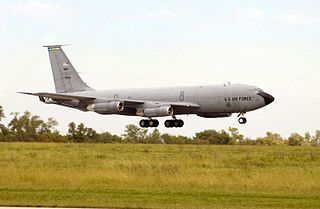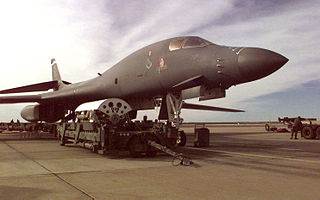
The 345th Bombardment Group is an inactive United States Air Force unit. Its last assignment was with the Tactical Air Command at Langley Air Force Base, Virginia, where it was inactivated on 25 June 1959.

The 117th Air Refueling Squadron is a unit of the Kansas Air National Guard 190th Air Refueling Wing located at Forbes Field Air National Guard Base, Topeka, Kansas. The 117th is equipped with the Boeing KC-135R Stratotanker.

The 38th Bombardment Group is an inactive unit of the United States Air Force. It was most recently assigned as the operational (flying) component of the 38th Bombardment Wing, stationed at Laon-Couvron Air Base, France, where it was inactivated on 8 December 1957.

The 70th Flying Training Squadron is reserve unit of the United States Air Force based at the United States Air Force Academy, Colorado.

The 64th Bombardment Squadron is an inactive United States Air Force unit that was last assigned to the 43rd Bombardment Wing at Little Rock Air Force Base, Arkansas, where it was inactivated on 31 January 1970.

The 65th Special Operations Squadron is an Air Force Special Operations Command unit which flies the General Atomics MQ-9 Reaper at Hurlburt Field, Florida. The squadron was first activated as the 65th Bombardment Squadron in January 1941, one of the original squadrons of the 43rd Bombardment Group. Following the attack on Pearl Harbor, the squadron participated in antisubmarine patrols until January 1942, when it moved to Australia and the Southwest Pacific Theater. It moved forward with US forces through New Guinea and the Philippines, moving to Ie Shima shortly before V-J Day for operations against Japan. It earned two Distinguished Unit Citations and a Philippine Presidential Unit Citation for combat operations. During this period, a crew from the 65th became the most decorated aircrew in United States history, when their B-17 fought off twenty Japanese fighters during a photo reconnaissance mission. The squadron was inactivated in the Philippines in April 1946.

The 403d Bombardment Squadron is an inactive United States Air Force unit. It was last assigned to the 43rd Bombardment Wing at Carswell Air Force Base, Texas, where it was inactivated on 1 January 1961.

The 71st Tactical Missile Squadron is an inactive United States Air Force unit. It was last assigned to the 485th Tactical Missile Wing at Florennes Air Base, Belgium, where it was inactivated on 30 September 1989 with the implementation of the Intermediate-Range Nuclear Forces Treaty.

The 405th Tactical Missile Squadron is an inactive United States Air Force unit. It was first organized in January 1941 as the 15th Reconnaissance Squadron. In early 1942, shortly after the attack on Pearl Harbor, the squadron's ground echelon moved to reinforce American forces in Australia, although the air echelon remained in the United States for additional training until August. While completing its training, the unit was redesignated the 405th Bombardment Squadron. The squadron moved forward through New Guinea and the Philippines, earning three Distinguished Unit Citations for its combat actions, operating from Okinawa in the closing month of the war. Following V-J Day, it moved to Japan and became part of the occupation forces until inactivating in April 1949.

The 498th Bombardment Squadron is an inactive United States Air Force unit. It was last assigned to the 345th Bombardment Wing at Langley Air Force Base, Virginia, where it was inactivated on 25 June 1959.

The 499th Bombardment Squadron is an inactive United States Air Force unit. It was last assigned to the 345th Bombardment Wing at Langley Air Force Base, Virginia, where it was inactivated on 25 June 1959.

The 500th Bombardment Squadron is an inactive United States Air Force unit. It was last assigned to the 345th Bombardment Wing at Langley Air Force Base, Virginia, where it was inactivated on 25 June 1959.

The 820th Bombardment Squadron is a former Army Air Forces unit, inactivated on 4 January 1946. The squadron was first activated during World War II as the 521st Bombardment Squadron. The squadron was soon engaged in the antisubmarine campaign off the Atlantic coast of the United States as the 16th Antisubmarine Squadron.

The 819th Bombardment Squadron is an inactive United States Air Force unit. Its last assignment was with the 30th Bombardment Group at Kahuku Army Air Field, Hawaii, where it was inactivated on 30 November 1945.

The 487th Bombardment Squadron is an inactive United States Air Force unit. It was last assigned to the 340th Bombardment Wing at Whiteman Air Force Base, Missouri, where it was inactivated on 1 September 1963. The squadron was first activated during World War II. After training in the United States, it deployed to the Mediterranean Theater of Operations, where it flew North American B-25 Mitchell medium bombers, primarily on air support and air interdiction missions, earning two Distinguished Unit Citations for its actions. After V-E Day, the squadron returned to the United States, where it was inactivated in November 1945.

The 424th Bombardment Squadron is an inactive United States Air Force unit. Its last assignment was with the 307th Bombardment Wing at Lincoln Air Force Base, Nebraska, where it was inactivated on 1 January 1962.

The 98th Air Refueling Squadron is an inactive United States Air Force unit. Its last assignment was with the 92d Operations Group at Fairchild Air Force Base, Washington, where it was inactivated on 1 July 1998.

The 423d Bombardment Squadron is an inactive United States Air Force unit. Its last assignment was with the 306th Bombardment Wing at MacDill Air Force Base, Florida.

The 345th Bomb Squadron is a United States Air Force Reserve squadron, assigned to the 489th Bomb Group. It is stationed at Dyess Air Force Base, Texas, where it is an associate unit of the 7th Bomb Wing.

The 302nd Tactical Missile Squadron is an inactive United States Air Force unit. Its last assignment was with the 487th Tactical Missile Wing at Comiso Air Station, Italy, where it was inactivated in 1991 with the implementation of the Intermediate Range Nuclear Forces Treaty.






















